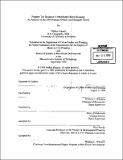| dc.contributor.advisor | William C. Wheaton and Henry Pollakowski. | en_US |
| dc.contributor.author | Fogarty, Nadine (Nadine Adria), 1969- | en_US |
| dc.contributor.other | Massachusetts Institute of Technology. Dept. of Urban Studies and Planning. | en_US |
| dc.date.accessioned | 2011-10-17T21:20:52Z | |
| dc.date.available | 2011-10-17T21:20:52Z | |
| dc.date.copyright | 1999 | en_US |
| dc.date.issued | 1999 | en_US |
| dc.identifier.uri | http://hdl.handle.net/1721.1/66393 | |
| dc.description | Thesis (S.M. and M.C.P.)--Massachusetts Institute of Technology, Dept. of Urban Studies and Planning, 1999. | en_US |
| dc.description | Includes bibliographical references (leaves 64-65). | en_US |
| dc.description.abstract | The property tax is a major expenditure for property owners, and a critical source of revenue for cities and towns. There are competing theories about the nature of property tax incidence in multifamily rental housing, for which empirical studies provide limited evidence. The Property Owners and Managers Survey (POMS) represents the first time information has been systematically collected about the expenses , revenues and other characteristics of multifamily rental housing in the United States. This thesis had two goals. The first was to explore the POMS data to see what information it offers about the relationship between property taxes, rents, values, and other characteristics of rental housing. The second was to evaluate the usefulness of the POMS data for estimating the incidence of the tax. A few results stand out after exploration of the POMS data. A significant share of properties reported effective tax rates well above the typical tax rate for cities and towns. These properties had more units and lower values than average, and less amenities. They were also more likely to be located in central cities in the Northeast and Midwest. Effective property tax rates for individual properties varied widely by region, and were significantly related to several key property characteristics. Analysis shows that the POMS data is not adequate to estimate the incidence of the property tax, chiefly because it does not provide enough variables to control for unit and neighborhood quality, hence differences in rents. Another significant drawback is the limited information about the location of properties. Future research might focus on finding ways to link this data with other sources of information to improve its usefulness. | en_US |
| dc.description.statementofresponsibility | by Nadine Fogarty. | en_US |
| dc.format.extent | 65 leaves | en_US |
| dc.language.iso | eng | en_US |
| dc.publisher | Massachusetts Institute of Technology | en_US |
| dc.rights | M.I.T. theses are protected by
copyright. They may be viewed from this source for any purpose, but
reproduction or distribution in any format is prohibited without written
permission. See provided URL for inquiries about permission. | en_US |
| dc.rights.uri | http://dspace.mit.edu/handle/1721.1/7582 | en_US |
| dc.subject | Urban Studies and Planning. | en_US |
| dc.title | Property tax incidence in multifamily rental housing : an analysis of the 1995 property owners and managers survey | en_US |
| dc.type | Thesis | en_US |
| dc.description.degree | S.M.and M.C.P. | en_US |
| dc.contributor.department | Massachusetts Institute of Technology. Department of Urban Studies and Planning | |
| dc.identifier.oclc | 45039906 | en_US |
